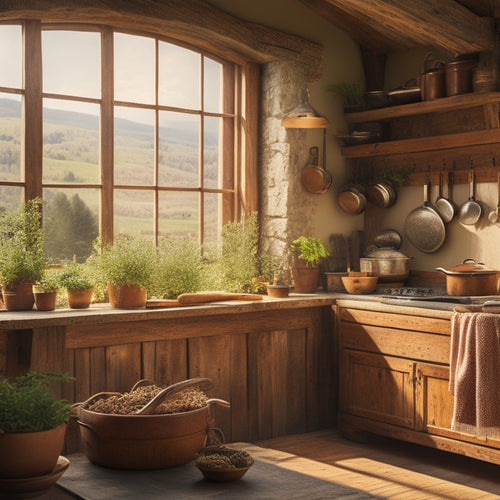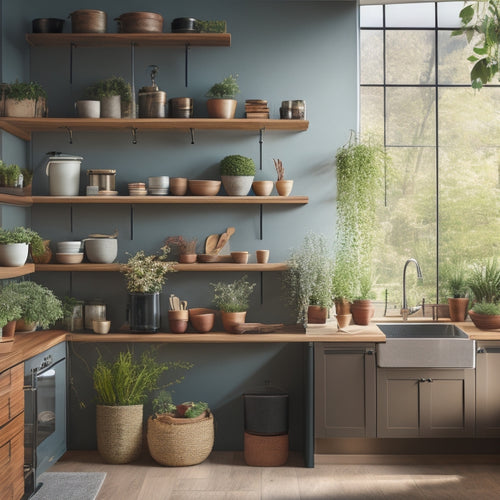
7 Essential Tips to Declutter Your Kitchen Space
Share
You can declutter your kitchen space by following seven essential tips. First, purge unwanted items you haven't used in a year and sort them into keep, donate, and discard piles. Next, assign a home for each item, categorizing them into groups like baking supplies or dinnerware. Optimize your kitchen layout by tailoring it to your cooking habits and needs, and use vertical storage wisely for less frequently used items. Designate zones for tasks like food preparation and cleaning, and implement a maintenance routine to keep your space organized. Finally, keep countertops clear, and discover how these simple changes can transform your kitchen into a clutter-free haven. By applying these tips, you'll be well on your way to a more functional, peaceful cooking space.
Key Takeaways
• Clear out unused items to free up space, sorting them into keep, donate, and discard piles to create a more organized kitchen.
• Assign a home for each item, categorizing them into groups and using organization hacks like labeling to maintain order and accessibility.
• Optimize your kitchen layout to fit your cooking habits, placing frequently used items within easy reach and creating flow for maximum efficiency.
• Maximize vertical storage for less frequently used items, using shelves, hooks, or pegboards, and grouping similar items together in labeled bins.
• Implement a weekly maintenance routine to keep your kitchen organized, including decluttering strategies and cleaning schedules to prevent clutter from returning.
Purge Unwanted Items First
Clear out anything you haven't used in the past year, as these items are likely taking up valuable space and contributing to clutter. This is the first step in your kitchen decluttering process, and it's crucial to be ruthless.
Sort items into three piles: keep, donate, and discard. Be honest with yourself – if you haven't used it in a year, it's probably safe to let it go. Create a donation pile for items that are still in good condition, and consider donating them to a local charity or thrift store.
As you declutter, think about your organizing strategy. Consider the storage solutions you need to keep your kitchen tidy. Think about the items you use regularly and how you can store them in a way that makes sense for your kitchen layout.
Assign a Home for Each Item
With your kitchen decluttered, it's time to assign a designated spot for each item, ensuring everything has a logical and accessible place to live. This pivotal step helps maintain your newly organized space and prevents clutter from building up again.
Start by categorizing items into groups, such as baking supplies, cooking utensils, and dinnerware. Then, identify storage solutions that work best for each group. For instance, use a utensil organizer near the stove or a spice rack near the cooking area.
Implementing organization hacks like container labeling and a minimalism approach will help you maximize your storage space. Label each container or shelf so you can easily find what you need. Adopt a 'one in, one out' policy to maintain a balanced amount of items in your kitchen.
Optimize Your Kitchen Layout
Optimize Your Kitchen Layout
Your kitchen layout should be tailored to your cooking habits and needs, ensuring that frequently used items are within easy reach and workflow is streamlined. By doing so, you'll maximize efficiency and create flow in your kitchen. To achieve this, consider the following layout principles:
| Zone | Function | Tips |
|---|---|---|
| Cooking | Prep and cook meals | Place frequently used cookware and utensils near the stove or cooking station. |
| Cleaning | Clean and sanitize | Position the sink and trash can near the cleaning supplies. |
| Storage | Store food and essentials | Designate a specific area for food storage and keep it organized. |
| Prep | Prepare ingredients | Allocate a counter space for food prep, with easy access to utensils and appliances. |
Use Vertical Storage Wisely
By allocating specific zones for different kitchen tasks, you've created a more efficient workflow, and now it's time to maximize your kitchen's vertical space to store items that are less frequently used. This will help keep your countertops clear and your kitchen feeling more organized.
Start by identifying the items you use infrequently, such as special occasion dishes, cookbooks, or baking supplies. Consider installing shelves, hooks, or a pegboard on walls or the back of a door to store these items. This will help keep them out of the way but still accessible when you need them.
When organizing your supplies, group similar items together and store them in labeled bins or baskets. This will make it easy to find what you need and prevent clutter from building up again.
Remember to keep the items you use most frequently at eye level, and store less frequently used items higher or lower on the shelves. By maximizing your kitchen's vertical space, you'll be able to keep your kitchen organized and clutter-free, making meal prep and cooking a breeze.
Designate Zones for Tasks
Organization is key to a clutter-free kitchen, and designating specific zones for tasks is an essential step in creating a functional and efficient workspace. By assigning specific areas for tasks like food preparation, cooking, and cleaning, you'll increase task efficiency and reduce clutter.
For instance, designate a zone near the stove for cooking and a zone near the sink for cleaning. This will help you stay focused on the task at hand and prevent clutter from building up in other areas.
To optimize space functionality, consider the 'work triangle' concept, where your most frequently used items are within easy reach. Place frequently used utensils, pots, and pans near their corresponding zones to reduce walking distances and increase productivity.
By doing so, you'll create a seamless workflow that saves you time and energy. Remember, a well-organized kitchen isn't only visually appealing but also enables you to serve others more efficiently.
Implement a Maintenance Routine
To prevent clutter from creeping back into your kitchen, set aside a specific time each week to maintain your newly organized space. This could be 30 minutes on Sunday evening or an hour on Wednesday morning - whatever works best for you.
Create a cleaning schedule that includes tasks like wiping down countertops, sweeping the floor, and tidying up your storage solutions. Stick to it, and you'll be amazed at how quickly clutter begins to dissipate.
Incorporate organization hacks, such as assigning a home for each item, using labels, and implementing a 'one in, one out' policy. Decluttering strategies, like the 'touch once' rule, can also help you stay on top of messes.
Keep Countertops Clear Always
You've set up a maintenance routine, now it's time to tackle the heart of your kitchen's clutter: the countertops, where clutter tends to accumulate and chaos can quickly ensue.
To keep your countertops clear, start by removing everything from them and sorting items into categories. Be ruthless – if you don't use it regularly, consider storing it or letting it go.
Once you've purged your countertops, think about how you can optimize your storage. Look for hidden storage solutions like slide-out drawers, spice racks, or a utensil organizer to keep frequently used items within easy reach.
Next, consider the decorative items you want to display. Choose a few statement pieces that add visual interest to your kitchen, and store the rest. Remember, the goal is to create a sense of calm and functionality in your kitchen.
Frequently Asked Questions
How Do I Declutter Sentimental Kitchen Items Like Grandma's Cookware?
When decluttering sentimental kitchen items like grandma's cookware, you're not alone; use sentimental item display strategies, decluttering techniques, and organizing heirloom pieces to create a functional space while honoring memories, and consider sentimental storage solutions for items you can't display.
Can I Repurpose Old Kitchen Items Instead of Throwing Them Away?
Did you know 80% of Americans feel guilty about wasting food, but upcycling utensils can ease that guilt? You can breathe new life into old items by upcycling them into plant markers or creative storage ideas, like a utensil-turned-potting-soil scoop!
What if I Have Limited Kitchen Space and No Room for Zones?
When you're short on kitchen space, you're not short on options. You're getting creative with storage solutions and utilizing vertical space to maximize every inch, making the most of your compact kitchen.
Are There Any Eco-Friendly Alternatives to Traditional Storage Containers?
You're looking for eco-friendly alternatives to traditional storage containers. Consider sustainable solutions like upcycling old jars or repurposing cardboard boxes, or opt for environmentally friendly options like bamboo or recycled plastic containers for a zero-waste approach.
How Often Should I Deep Clean My Kitchen to Maintain Organization?
You should deep clean your kitchen every 1-2 months to maintain organization, focusing on high-traffic areas and implementing monthly maintenance best practices, especially in small kitchens where clutter can quickly accumulate.
Related Posts
-

Rustic Hanging Racks for Country-Style Kitchens
Rustic hanging racks are a game changer for your country-style kitchen, blending functionality with charm. They maxim...
-

Easy-To-Install Kitchen Wall-Mounted Racks
Installing easy-to-use kitchen wall-mounted racks is a smart way to maximize your space. These racks help keep your c...
-

Affordable Sliding Pantry Drawer Solutions
If you're looking for affordable sliding pantry drawer solutions, you're in the right place. These drawers maximize s...


